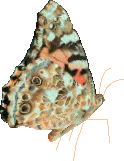 The Painted Lady may be the most widespread butterfly in the world. It also known as the thistle butterfly and the cosmopolitan (because it is so widespread, occurring in North and South America, Europe, Asia and Africa). This flying insect lives in temperate and some tropical areas.
The Painted Lady may be the most widespread butterfly in the world. It also known as the thistle butterfly and the cosmopolitan (because it is so widespread, occurring in North and South America, Europe, Asia and Africa). This flying insect lives in temperate and some tropical areas.
Egg: The Painted Lady begins its
life cycle as an egg that is the size of a pin head. Eggs are pale green with 12 to 14 longitudinal ridges; they are laid on thistle, mallow, or hollyhock leaves. The incubation period is 3 to 5 days.
Caterpillar (larva): The caterpillar eats continually for 5 to 10 days before it pupates. The purple to black caterpillar has long spines on each segment; there are yellow-green stripes and large white dots. The caterpillar is up to 1.25 inches (3 cm) long. It builds a silky, webbed nest as it feeds, usually eating thistle, mallow, malva, hollyhock, sunflower, or canola. As the larva grows, it sheds its skin (this is called molting). The time between sheddings is called an instar; each instar has slightly different coloring.
Chrysalis (pupa): When the caterpillar has grown to the right size, it pupates. It hangs upside-down from a leaf or branch, and attaches itself with a single silken string. An adult forms from the caterpillar, whose internal structure changes completely. The chrysalis becomes almost transparent when the butterfly is about to emerge. An adult will emerge about 7 to 10 days after the chrysalis has formed.
Adult: When an adult emerges from the split chrysalis, it hangs upside down and pumps blood into its four wings, inflating them.Then it waits for its delicate wings to dry. It can fly a few hours after emerging.
The adult Painted Lady is mostly black, brown, and orange with some white spots; the underside is gray with white and red markings. The adult has a 2 - 2 7/8 inch (5.1 - 7.3 cm) wingspan. Adults sip sweet thistle and clover nectar. Adults can mate in about a week after emerging; adults only live about 2 weeks.
Migration: Adults from colder parts of North America overwinter in Mexico; adults from northern Europe migrate to North Africa and southern Europe.
Classification: Order Lepidoptera (butterflies and moths), Family Nymphalidae (brush-footed butterflies), Genus Vanessa, Species V. cardui.
Painted Lady Printouts and Activities:
For further information log on webiste :
http://www.enchantedlearning.com/subjects/butterfly/species/paintedlady.shtml




